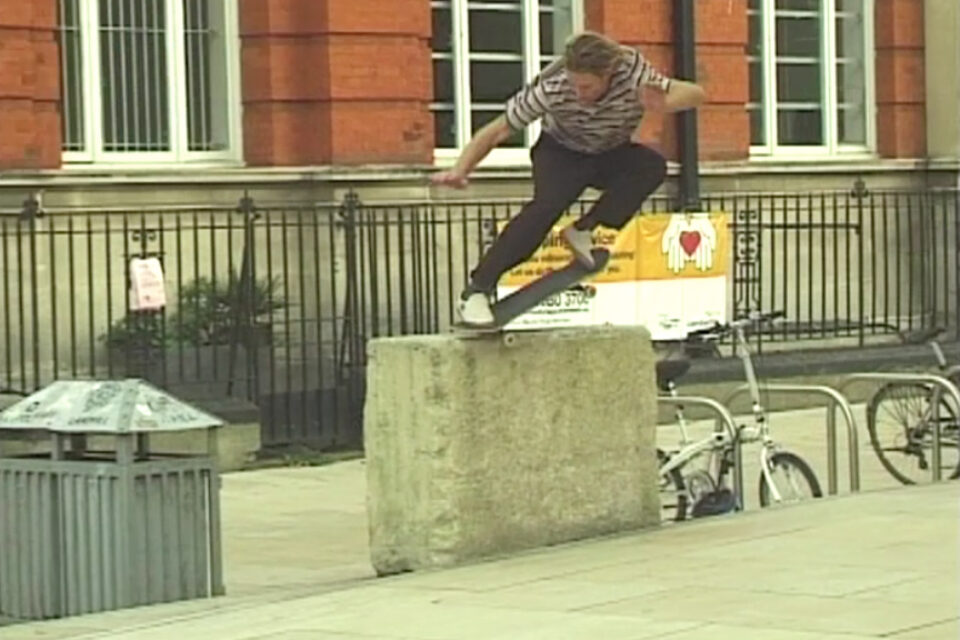Previous post
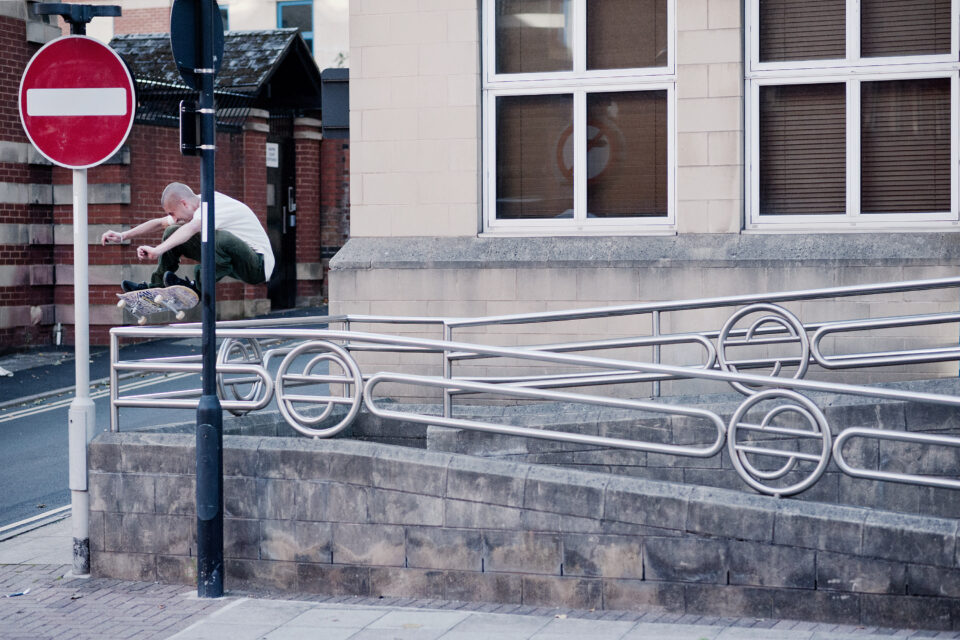
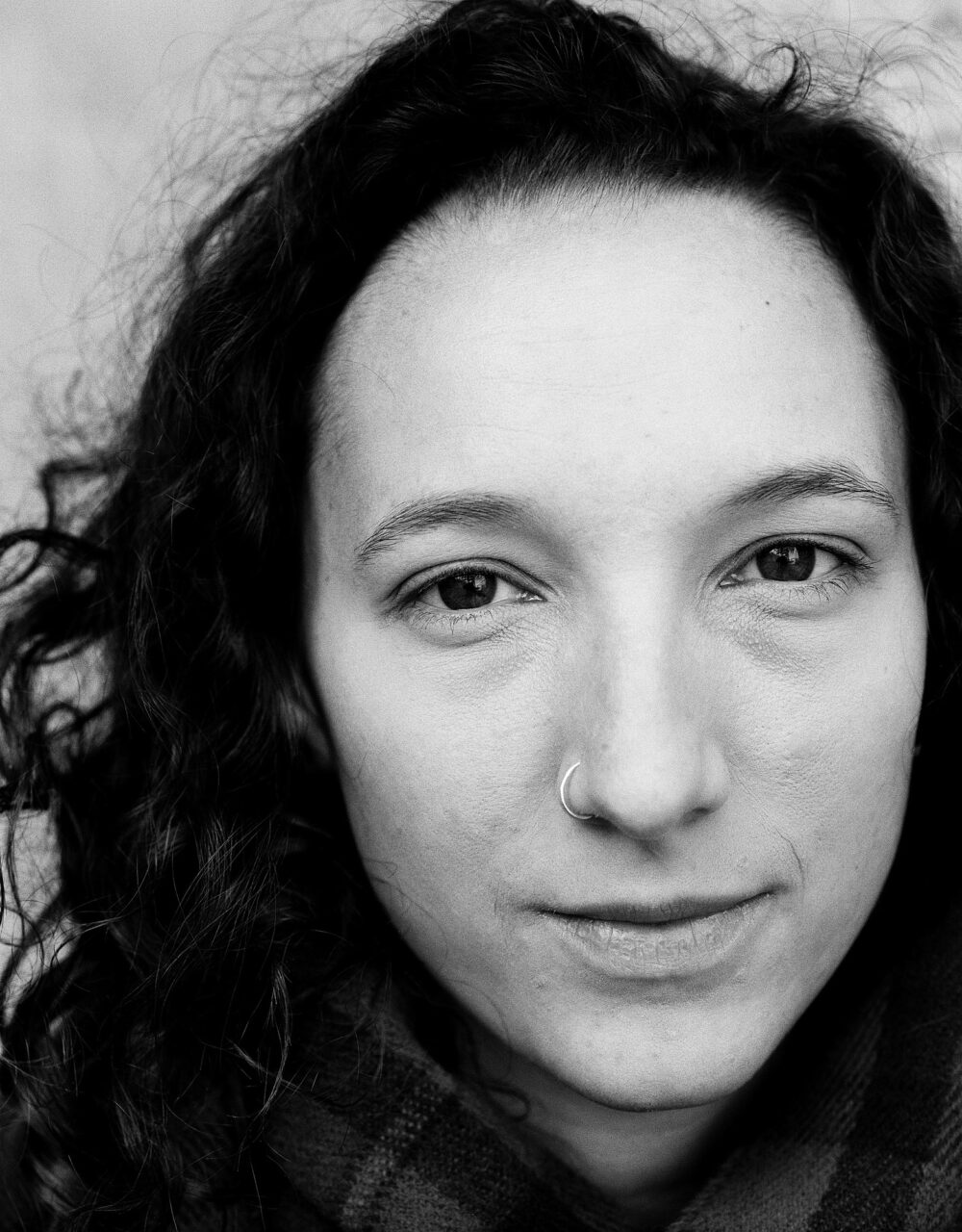
Interview: Kingsford
Portrait: Kembery
You have been working on the No CompIy exhibition at Somerset House, which was meant to have opened in June but is now postponed until next year thanks to coronavirus. How did you get involved with that project?
Last Easter I got asked to help with some promo for London Street League, which was funny because I actually didn’t go. They wanted female and male UK street skater representatives – so it was me and Alex Decunha – to do some interviews with ITV, Sky Sports and the Evening Standard for a bit of cash. We got to go on the Anish Kapoor Olympic slide, which was fun. When I went into the office (at Somerset House) that afternoon – I share the space with the press team – they all had the Evening Standard article up on their screens. One of my line managers circulated it around the office and it got to the senior curator, who sent me an email saying: “Oh that’s funny, I had a chat with a friend who put forward the idea of a skate boarding exhibition here, would you be up for having a catch up with me at some point?” And I did – I talked at the senior curator for a couple of hours solid about everything skateboarding. That was my foot in the door really.
What was your role there prior to working on No Comply?
I have a few different roles there. I mostly work as sort of a part-time duty manager / gallery supervisor for the exhibitions and if there are any events with artists-in-residence in the studios I sometimes help them out.
So your knowledge of skateboarding helped get you a promotion at work. Now you’re an assistant curator.
I’m just doing more part-time stuff for another department, so technically it’s not a promotion, but I guess on my CV it definitely is. There’s a running joke with friends who work in galleries and friends from school. We call it the ‘c’ word. To be a curator is to get to be the ‘c’ word. It’s so easy to throw that idea out there when you go to careers day at school. You think: “Oh wouldn’t it be great to be the type of curator that comes up with concepts and ideas to exhibit”, and it’s like that will never happen unless you work from the ground up or if you’re in the right circles, like who you know. So being fortunate enough to be in such an institution anyway, and having a niche, being a skateboarder, that’s the way I got in.
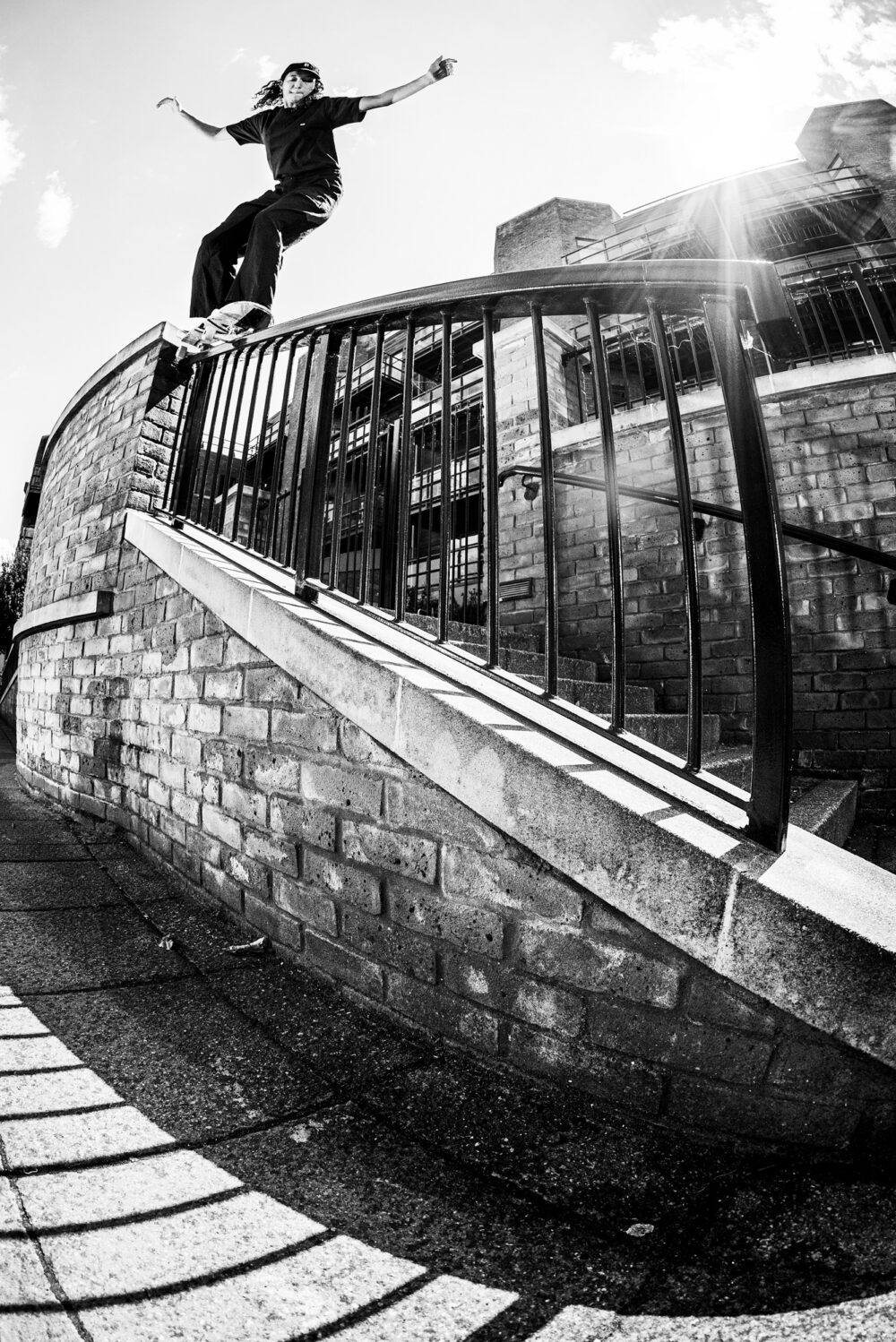
Tell us about the exhibition.
I explained that to try and summarise the culture and communities within skateboarding in a way that will appeal to non-skaters but also not offend skateboarders is near impossible. So we narrowed it down to mostly focus on the UK skateboarding scene. I explained how the American skateboarding scene is very different to the European scene, and that the UK has a lot to offer for an exhibition. The full title is ‘No Comply: Skate Culture and Community’. There are three rooms and each room has a vague theme. The first room is going be looking at this idea of the freedom of skateboarding – the architecture and cities and the landscape of the UK that provide great opportunities for street skating. The middle room will look at the different communities across the UK and the DIY skateboarding scene. It will cross the board, looking at the female and LGBTQ+ scenes, but I think it does expand briefly to Europe and some of the NGOs as well, like Skate Nepal and SkatePal. The last room will look at wellbeing and mental health and skateboarding in the UK, so for example the Ben Raemers Foundation and skateboarding in education, this idea that skateboarding crosses all channels really, that it’s very much something that can suit a lot of people.
Hopefully there will be a pop-up shop too. We’ve tried to get Palomino and Brixton’s Baddest to help curate the shop. It’s been really tricky trying to navigate funding but myself and the other curators have been adamant that we need grassroots people doing the shop, setting the tone for… going along with the DIY theme and also supporting local small businesses.
How has coronavirus affected your job at Somerset House?
I was furloughed for my main role there. I think that lasts until October. I haven’t been back to the office yet.
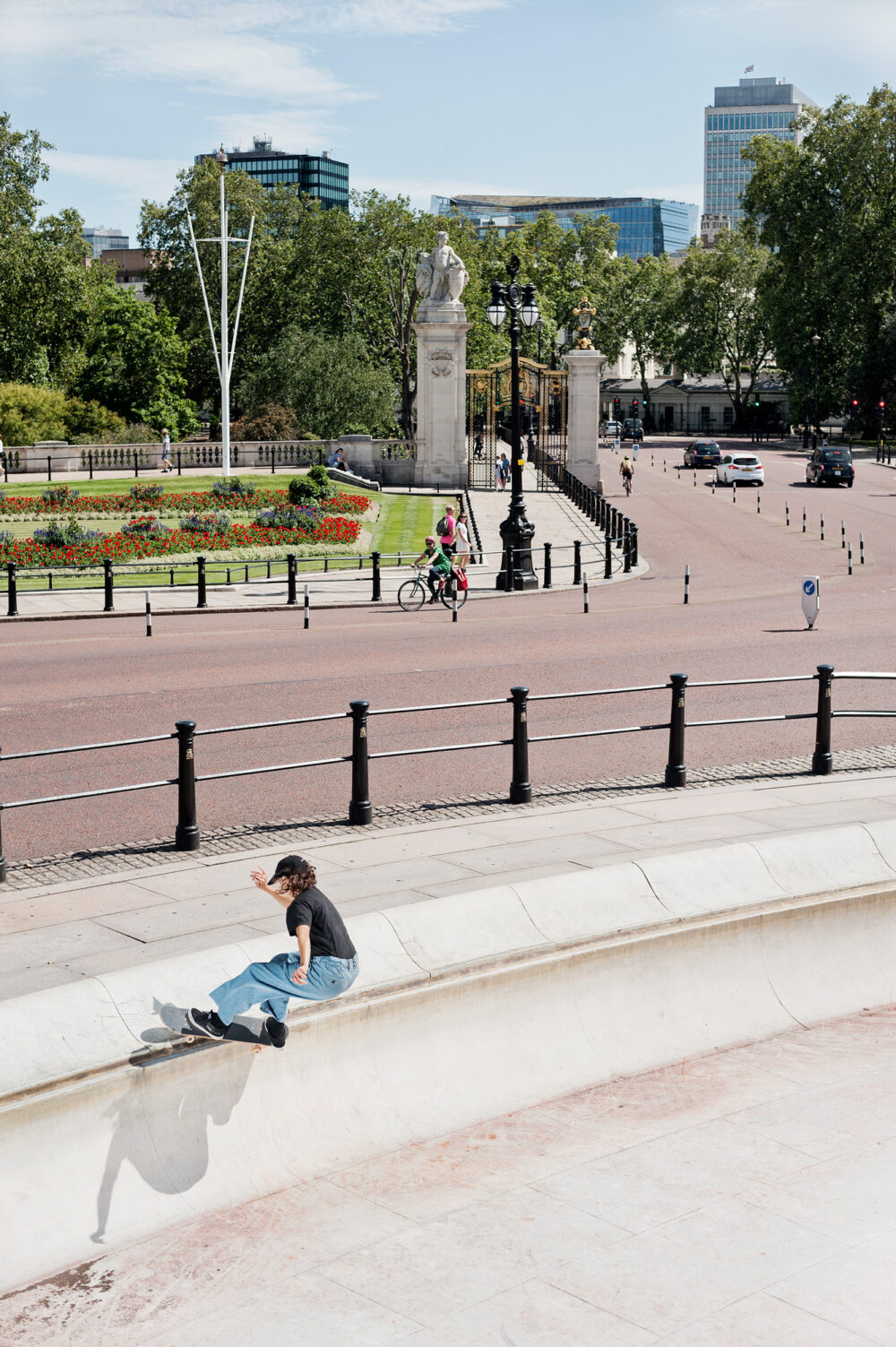
What about your other job – skating? How has that been affected by the pandemic?
I always find it funny to think that it’s a job. I guess it’s more my job now than anything else, which is amazing. I’ve been out and about filming for a couple of projects and getting photos too. I’ve obviously missed out on a couple of trips because they all got postponed, but I’ve been very much making the most of lockdown London. Everyone has got a bike now and it’s so much fun to cycle around the city and skate spots, especially spots in the centre where a lot of offices are still empty and security’s a little lax. I’ve been really enjoying that. I feel like a grom again, because I’ve been skating some of the spots I skated when I first started without getting kicked out.
What about earlier in lockdown?
Skating then was a funny juggle of wanting to skate, not wanting to impose on the NHS, which was already really stretched, and also not wanting to promote skating, so you didn’t want to document it. Also it was a bit like: “Are you allowed? Is it exercise?” The government never really knows what category to pin it to.
Moving on, tell me a little bit about your band Upset Stomach.
I went to university in Norwich where I met a very good friend of mine, Laura, who is the lead singer of Upset Stomach. She always had her own project called Strange Lipsticks and she used to do a lot of stuff with her friend from home Bradley, who is the guitarist in the band. They both moved to London after university and wanted to make their duo or solo thing more of a band and a live performing unit, so they asked me. At the time I’d just left another band. I think they found our amazing bass guitarist Ed at the New Cross Inn. Everyone formed a friendship and then we were in a practice room together and we’ve never looked back really. I’ve actually been playing the drums longer than I have been skateboarding, I think since I was about 11. I had a lot of lessons at school and convinced my parents that I was going to stick it out, so after playing pots and pans and taping spoons to the bottom of my feet, I got a drum kit for joint Christmas-birthday present and have forever played in bands. But this one has really stuck out because we’re all serious / non-serious about it. We love to play together and write songs, but we also understand that we’re never going to actually make it, but that we can still have a laugh.
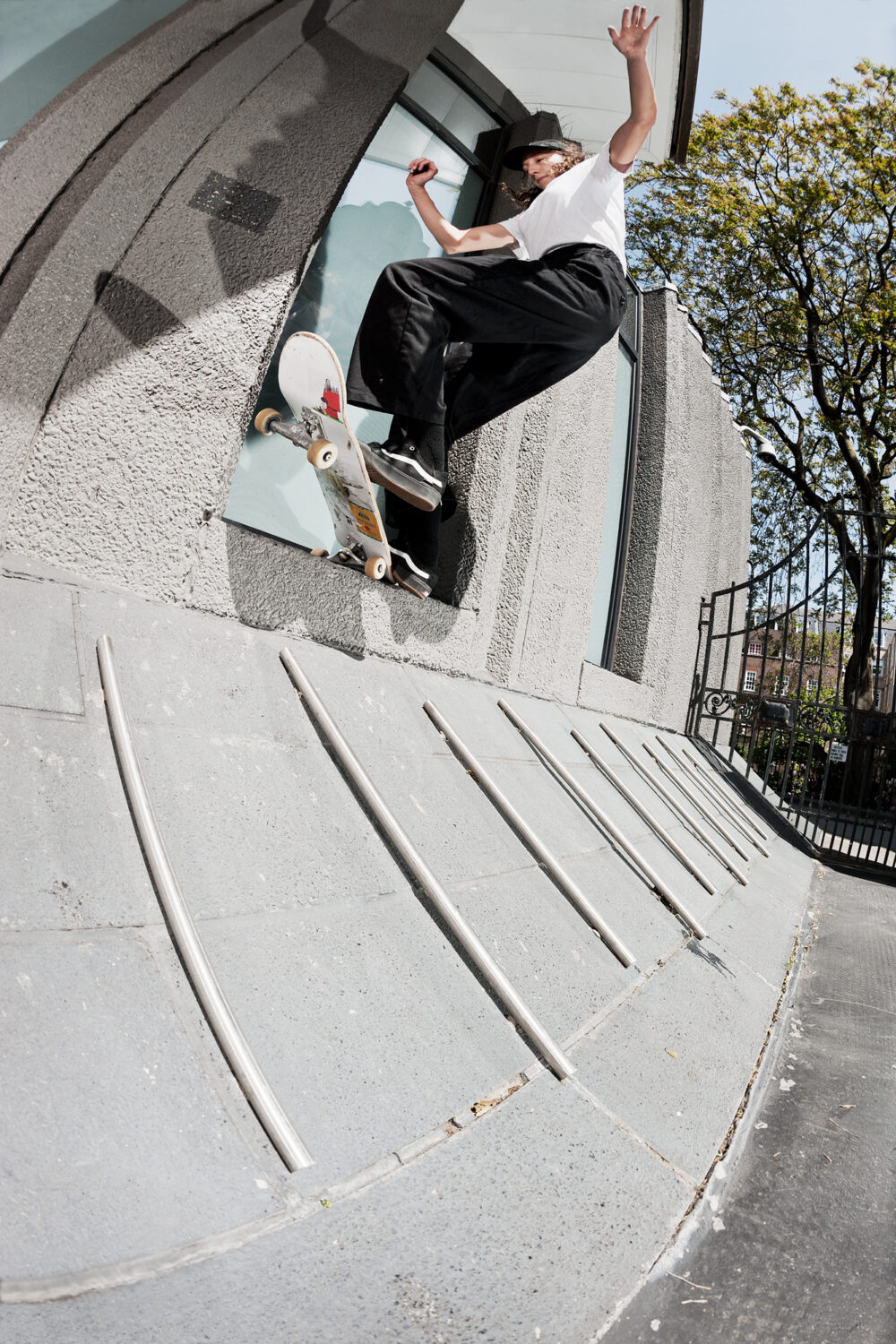
How would you describe Upset Stomach’s sound?
We have a bio. It gets weird: “Autotuned plastic trash, epic cathedral treble, unnecessary prog breakdowns. Upset Stomach’s non binary panic attack of cartoon sounds are the perfect shoegaze pop to send your ex at 3am”
Nice. You mentioned that you’re never going to make it, but you do play shows and record, right?
When I say: “Not make it”, it’s more of a joke because we have this running joke that we’re probably a bit too old to go anywhere with it, but we had a lot of gigs around London and we did a little tour of the Midlands last summer – we played three gigs in a row, one in Nottingham, one in Derby and one in a friend’s shed. At one point we had one practice a week and it would be an all-dayer, from like 10-6. So yes, it (the pandemic) put everything to a halt unfortunately. We had a gig booked at a little festival called Indietracks and that got cancelled. It all went online as a Zoom event, so we recorded two tracks in Ed and Bradley’s garden and made a music video. That went on the online festival, which was quite funny. It was a socially distanced, mask-wearing, electric drum kit with an extension cable out into the garden set-up. It’s been quite tricky because practice rooms are closed and we’re all trying to work out ways to get by in different jobs, so it’s taken a bit of a quiet turn, but we’re definitely still trying to organise getting together to get some more tracks recorded and produced, and keep writing I guess. I usually just turn up and try and be a human metronome to it all.
Going back a little bit, you mentioned that you went to university in Norwich. What did you study there?
Illustration. I did architecture at A-level then ended up falling into the illustration pathway at Camberwell, where I did my foundation. I didn’t actually finish that because the course was so oversubscribed. I felt like I wasn’t getting anything out of it. I actually still got my certificate in the post for completing my foundation, even though I dropped out, which I thought was weird. Before I left I asked my foundation course tutor the top five universities to apply to for illustration, I sent an application and ended up at Norwich University of the Arts. I really enjoyed printmaking and the processes so it was a really great learning curve. I had a great time.
So having grown up in London, how did you find moving to Norwich?
Partly why I chose it was because it was the polar opposite of London. If I’m going to move out I might as well go somewhere that’s not another big city, as much of a contrast as possible. And also I checked out the local skatepark at every university I went to visit and Eaton Park (in Norwich) had just got a new concrete park and it was amazing. That kind of swayed me. I loved it. It felt like being on a giant campus because it’s such a small city to get around. You get to know all the locals and Drug Store skate shop is amazing. Sam (Avery) is such a legend. So it felt like an extended family from uni friends and the skate scene there.
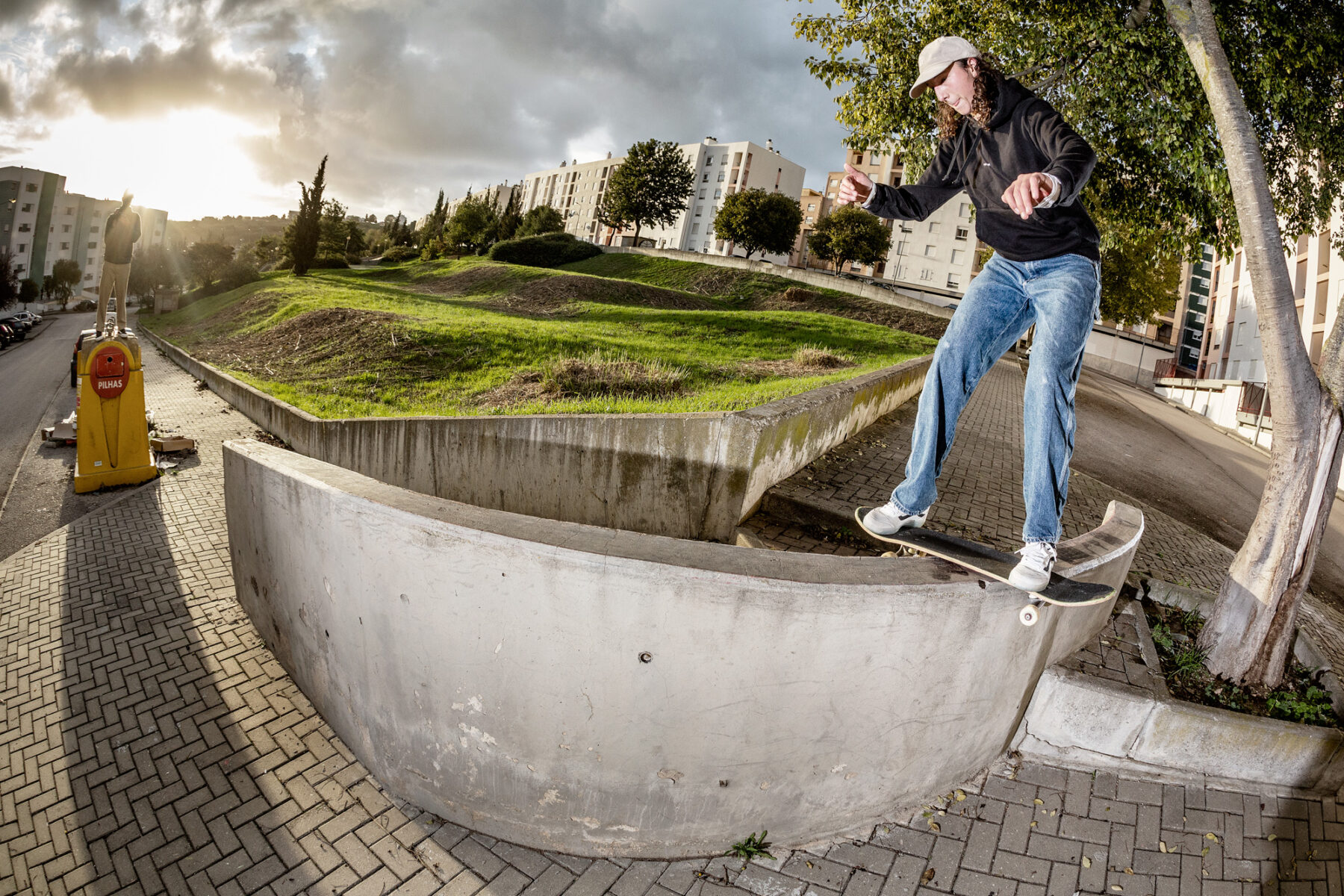
With your curating work, your illustration background, the band and skating, you have lots going on. Where do you see your focus later in life in terms of a career? Or do you see yourself always doing different things?
I feel with quite a bit of certainty I can never see myself doing a Monday-Friday. Work experience and internships that were Monday-Friday, even for a month or two… I realised that it really wasn’t for me. I’d rather work a seven-day week and have two days off knowing that I might have a shorter week following, or something else going on. I like the freedom of a part-time role so that I can juggle the things that interest me or different events that pop up.
Moving back to skating you were recently part of two women-only video projects – Arms Wide Open by Sirus F Gahan and Credits by Shari White. You’ve been a sponsored skater for a long time. How do these projects compare to mixed projects and perhaps being the only woman on trips in the past?
It’s a funny one. I grew up skating with a bunch of boys – there were no girls around – so I very much got used to that. After first stumbling across other female skaters, it didn’t necessarily change who I wanted to skate with, but there is a certain affinity with being amongst females because we’re biologically similar. I enjoyed getting to know female skaters because I feel like there was a similar mentality to skateboarding and a process with skateboarding. I found some tendencies to overthink things when I try a new trick and some of the friends I grew up with – the guys – were very good at just switching off, and the tricks would work. Sometimes I found it comforting to know there are like-minded and physically similar skaters to me. But I really didn’t notice too much of a difference with all-girl trips. I’ve always felt very welcomed by anyone so all-girl trips were just a laugh. But we had Manhead (Josh Young) on there, we had Sirus filming it. It was still a mix, it was just more outnumbered the other way. I guess I got my nails painted, that was probably more of a difference. But Sirus did too so…
What about filmers and photographers? In Indonesia you had Norma Ibarra and Sara Parson-Texas shooting photos, and Shari filmed and directed Credits. Do you find it easier working with media people who are women, or is it more to do with the individual?
Honestly I think it’s totally down to the individual and their character. Norma is wonderful. Before Indonesia I went on a trip with her to India. It was thrown together by Ati (Atita Verghese) who’s from Bangalore, and I just remember she was always asking, always being really honest, and wanted to make sure she was catching the skate trick at the right time in the right position. Sara has a great eye for capturing the natural friendships and relationships, different characters and cities. Shari is an amazing filmer – she’s practiced catching it the right way. With any photographer or filmer I always ask: “Is that good enough? Are you happy with it?” As long as the filmer or photographer is happy I don’t mind. Guy or girl, it’s just down to the individual.
I feel like having a project that was all-female was just to show the industry that it doesn’t really matter. It is heavily male-dominated in skateboarding, but there are some incredible females who can do it too. I think it’s important to showcase that females can do it too and that there should be equal opportunities.

How do you think more women and LGBTQ+ people could be encouraged to start to shoot photos and film skateboarding?
I think similar to skateboarding in general – if there’s more exposure to show there are female and LGBTQ+ filmers, photographers and board companies… Social media is playing a massive part in that because it’s made it easier to see that others are doing it. That’s what I think is going to encourage more to start. Jeff Grosso’s Love Letters are groundbreaking because they transcend generations of skateboarders as well as scenes and really help give people the confidence to pursue something that they’ve really wanted to but maybe didn’t think they could. I know Vans is doing that at the moment with Skate Witches as well. They’ve got photography workshops with Norma and filming workshops with Shari and things like that. I think that’s really helped.
Do you remember ever feeling unwelcome in skateboarding?
Not really. I’m trying to reflect. Thinking back to when I first got on Vans UK, I was always quite welcomed. I don’t think skateboarding was that cool in the early 2000s. There was not as much money in it. Any trips I went on were off my own back and through connections with others that wanted to do that too. I still remember Ben Powell commentating at events and being stoked on getting photos in Sidewalk and things like that, so I always felt really included in that sense. There weren’t that many female skaters. We were quite hard to find so you would get snapped up a lot quicker with opportunities and sponsorship if you were female than if you were male. I always remember thinking: “I started skating at the same time as all my guy mates. I’m sponsored and they’re not purely because I’m the only girl”.
Not purely.
Not purely, but it’s not as competitive so you can get a bit further in that sense.
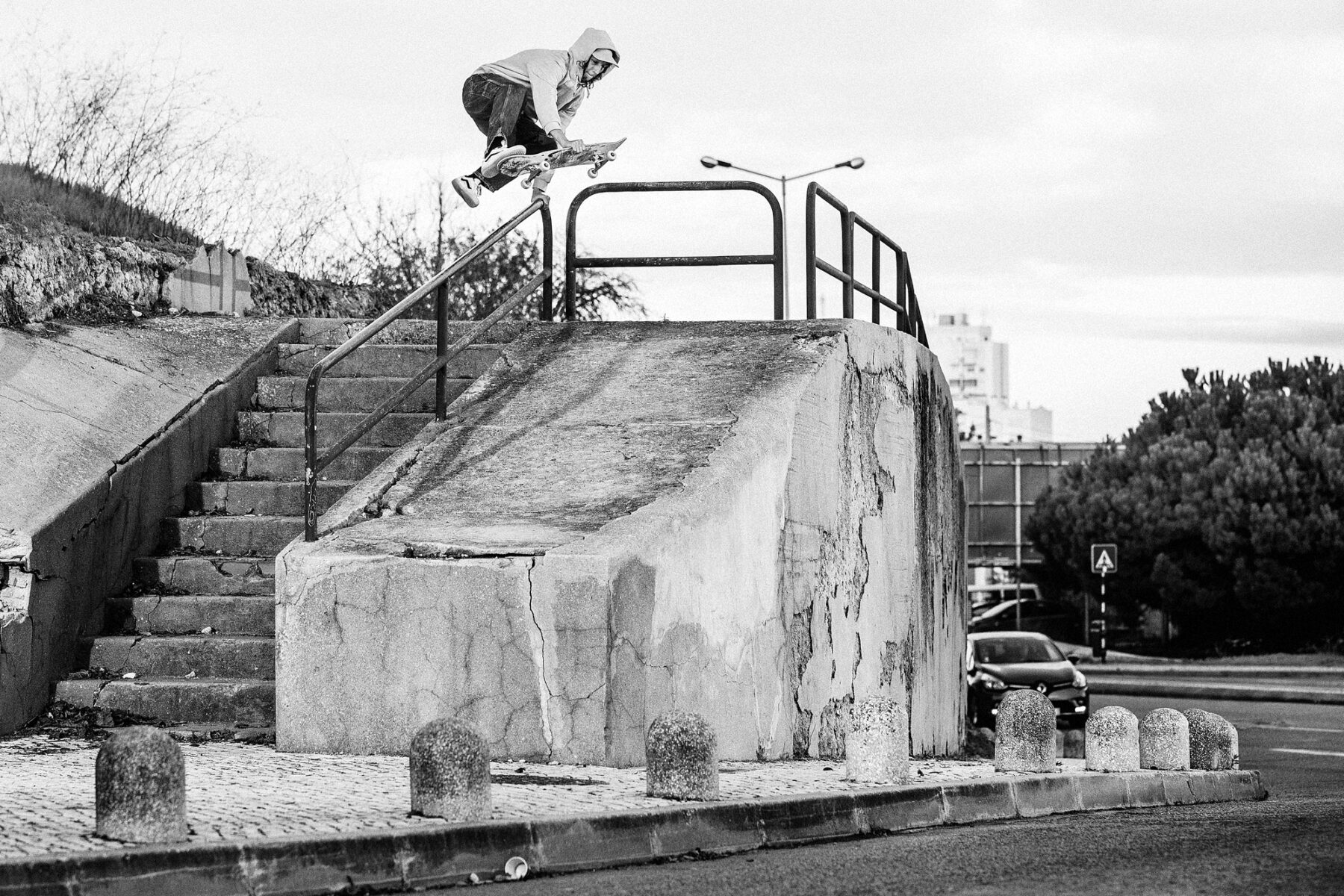
Is skateboarding welcoming to women and girls today?
It’s actually insane. Now if I go to any skatepark or even just walk around the city there’ll be girl skaters everywhere, one at every park. It never used to be a thing. It took me a whole year to come across another female and that was Sam Bruce in north-west London and I was in south-east. One problem now is that because there is more light on females and more of a push from the industry to show the scene, there can be internet trolls that are jealous. Maybe they think girls are getting hooked up too easy. It’s always going to be a problem. If you’ve got more followers on social media but you’re not necessarily the best skater, you’re probably going to get more endorsement. That’s probably from somebody in the company that sees marketability as more important than skateboarding ability. I have seen a lot more stupid comments on girls’ videos.
Maybe I always felt welcome because I was quite naive. I was just like: “I’m just a skater”, which was great. I felt accepted into that social group. I never really thought that anything could come from it. At the time I felt like there were maybe one or two UK skaters that were just about getting by skating for a living. Now because of all the money and the light that’s shed on the female and LGBTQ+ scenes and the smaller communities within skateboarding, a lot of people in marketing are throwing stuff out there. I think it sometimes causes a lot of tension.

Are you talking about sponsorship?
Sponsorship or just a cold brew coffee company being like: “We want to use a skateboarder in our ad campaign,” and they want to use a girl because it’s slightly more underground or edgy. When it comes to actual skateboarding sponsorship I have definitely witnessed a lot of hostility from certain people against females getting hooked up. Stef Nurding did a pretty good job at addressing trolls on social media recently, she nailed it really. Skateboarding is not easy. It is intimidating being a female or from a smaller community within skateboarding. It’s getting less intimidating, but it definitely still is. Teaching all-girl sessions recently, I know that a lot of them never skated with a guy before. They only ever came to the all-female sessions because that’s where they felt comfortable, which is fair enough. It’s great that there’s a space for them, but in a way creating separate spaces is sort of dividing people’s perception of the scene, which I found very welcoming. I know that’s not the case for everyone but I was fortunate to find a crew that was. I think if you show that you’re really giving it a go at the skatepark or wherever, you’re probably going to be encouraged by the locals.
I think a lot of guys – especially older guys – struggle to get the right balance at the skatepark. They want to be encouraging but don’t want to seem patronising.
It’s such a tricky one. Sometimes I’ve witnessed guys – maybe even girls – giving way too much praise for a trick that the girl skater can probably do easily. Even though it’s innocent and probably coming from a good place, it can come across as patronising. It shouldn’t be that much of a shock to you that a female is able to do it.
I remember when there weren’t that many good skateparks, so you would practice on your road in front of where you lived before you ever went to a skatepark. Now because there are so many, that’s where beginners will go. They see it as a facility for learning, which is great, but I think it’s hard to get used to someone not even doing a trick but carving or rolling around. People may think: “You should learn to do that out of the skatepark before you come in”, but it’s really unfair to think that.
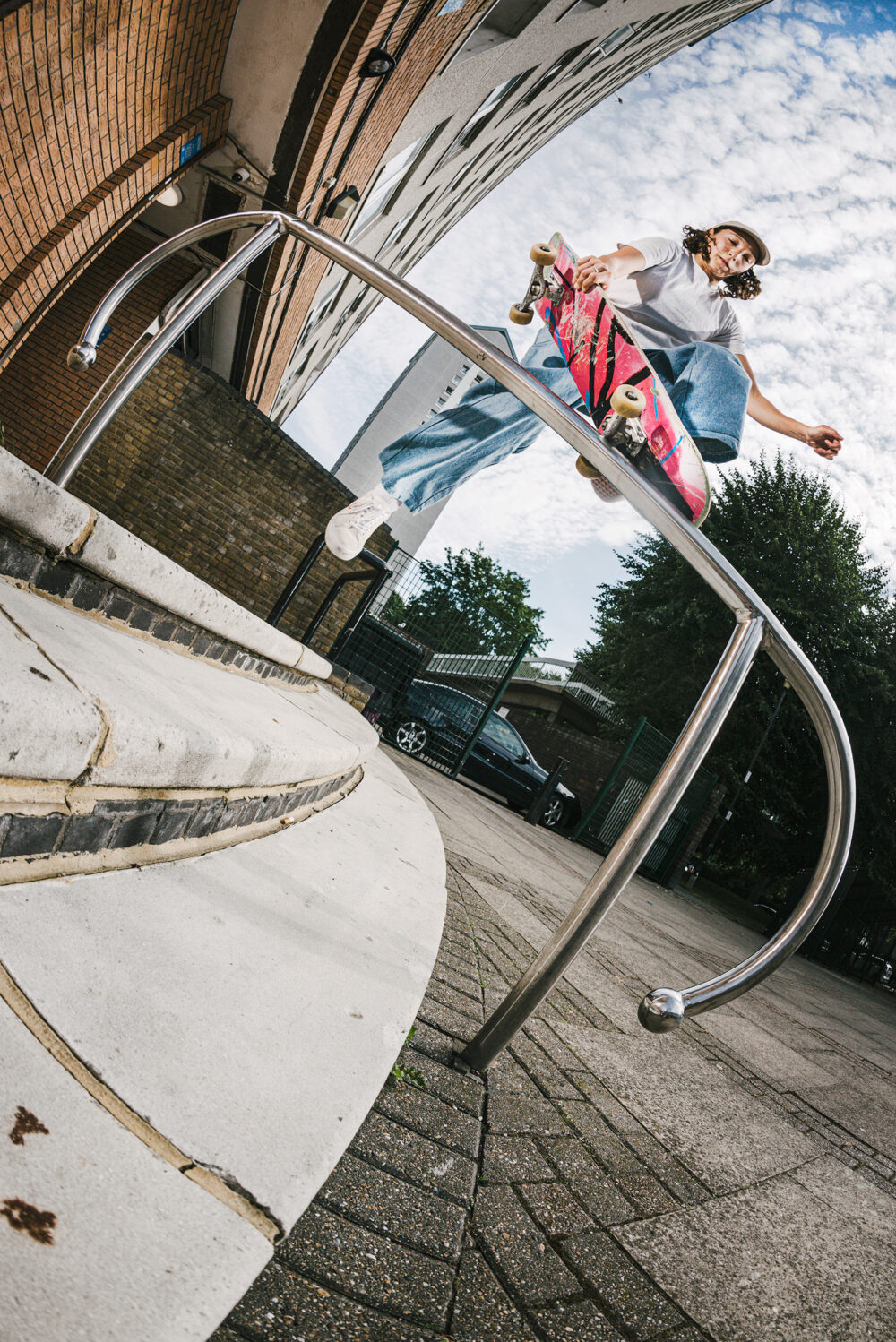
You recently started riding for Poetic Collective. How did that come about?
I met Tom (Botwid), who runs Poetic Collective, in Malmö. I went for the Skate Malmö Street and Ultra Bowl events and returned because there are amazing street spots, parks and facilities. He was always super supportive of my skating and asked if I wanted to be on the team. It hadn’t been long since I’d started getting boards from Santa Cruz, my first board sponsor in a while. They took me on trips around the UK and Barcelona, so I didn’t want to get up and leave, but at the same time I was really hyped on Poetic Collective and their riders and Tom. Also they make beautiful clothes, the best fitting trousers I’ve ever skated in. It’s a smaller company, so it feels like there is room to go for it and help it grow. But I’m super grateful to Alan (Glass) at Shiner for hooking me up in the first place.
What are your plans for the rest of the year?
It very much depends on travel regulations. I hope a couple of trips that were postponed might still happen. September is a combination of work and skate camping trips – I’m really looking forward to those.

